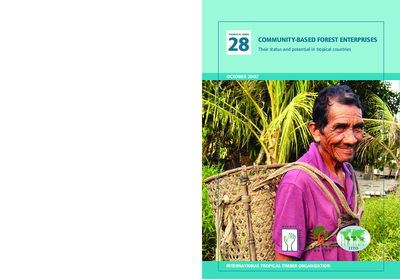Community-Based Forest Enterprises: Their Status and Potential in Tropical Countries

Author(s): Augusta Molnar, Megan Liddle, Carina Bracer, Arvind Khare, Andy White, and Justin Bull
Publication Date: 2007
DOWNLOAD FILEKey points in document
- The review summarizes data from 20 case studies of community-based forest enterprises (CFEs) in which rural people collectively manage the production, processing, and/or trade of forest goods and services in forests over which they have access and use rights.
- The document first provides an overview of the market and social and political context within which CFEs operate. It then focuses on enabling conditions identified from the case studies affecting enterprise emergence and growth, including those related to organizational structure and economy of the enterprise, and discusses social and environmental benefits arising from the enterprise. Finally, case study findings are used to identify internal and external barriers and constraints to enterprise success.
- This review found that CFEs can be very profitable, but that internal constraints, market barriers, and regulatory and policy barriers can limit CFE emergence and growth.
- Important enabling conditions that can address these barriers include (1) ensuring that the regulations, including tax mechanisms, that are in place do not impede the formation of CFEs or make them uncompetitive; (2) that community stakeholders have secure tenure and access to forest resources, including authority to make key decisions; (3) that community stakeholders are part of the policy dialogues and decision-making that affect their right to own, use, and trade forest products and services; (4) building governance structures and legal supports for overseeing CFEs; and (5) building skills and capacity related to business aspects, financial management, and technical information needed to establish and grow CFEs.
Information relevant to Learning Questions:
Are enabling conditions in place to support a sustainable enterprise?
- Stakeholder alignment, diversification
- Market demand, profit potential, access to credit/capital
- Ownership, governance
- Government requirements, policies for enterprises, business alliances
- Financial management capacity, technical capacity
- Inputs, equipment, infrastructure
- Biodiversity linkage, policies for and enforcement of resource use, planning for external disturbance
Does the enterprise lead to benefits to stakeholders?
- Increased income for participants
- Non-cash benefits
Do the benefits lead to positive changes in attitudes and behavior?
- Attitudes regarding sustainable use of resources
- Behaviors regarding sustainable use of resources
Does a change in stakeholders’ behaviors lead to a reduction to threats to biodiversity (or restoration)?
- Biological resource use
Does a reduction in threats (or restoration) lead to conservation?
- Forest ecosystems
- Freshwater ecosystems

